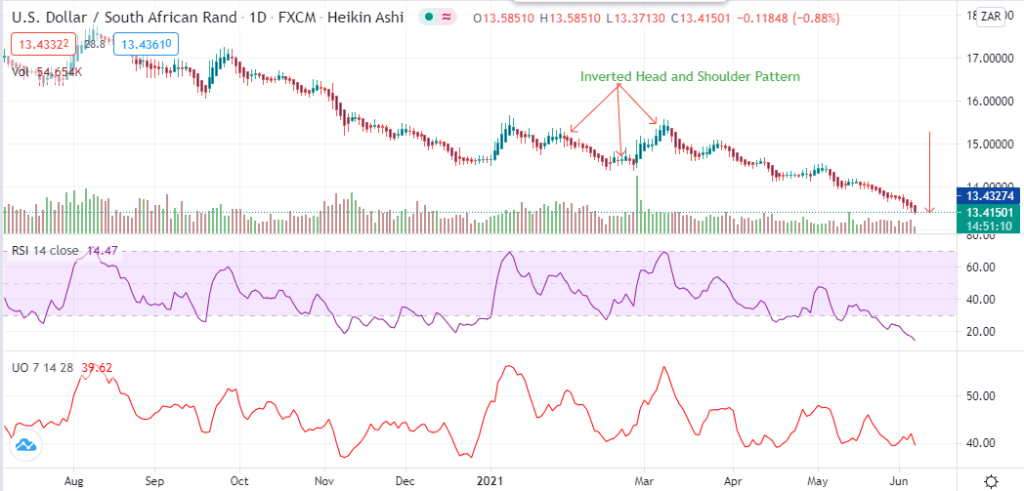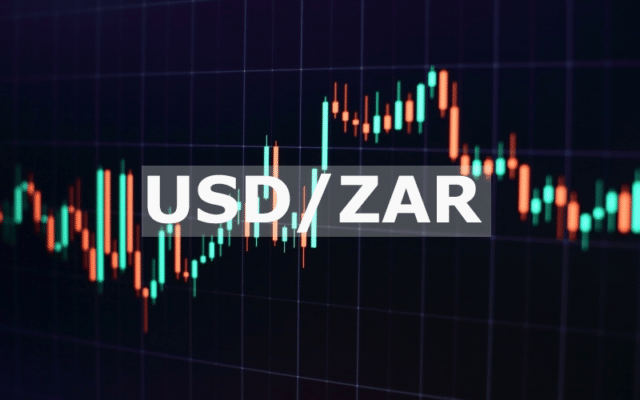- South Africa’s annualized GDP growth rate (QoQ) stood at 3.1%. In Q1 2021.
- SA unemployment rate hit an all-time high at 32.6% in Q1 2021.
- US manufacturing payrolls in May 2021 failed to beat estimates but rose to an annual high at 12.29 million in May 2021.
The USD/ZAR traded at -1.47% on June 4, 2021, from the previous day. It closed at 13.4292 after opening at 13.6242. The dollar has lost 2.39% to the South African rand in the week leading to June 4, 2021, signaling a 20.52% decline year-on-year.
The rand gained ahead of the release of Q1 2021 real GDP data on June 8, 2021. According to Bloomberg consensus estimates, the quarterly annualized GDP growth rate put the economy at 3.1%. Q4 2020 saw the economy jump 6.3%, with yearly estimates showing an increase to -3% from -4.1%.
Unemployment rate
Q1 2021 saw South Africa record the highest unemployment rate at 32.6% (0.1% higher than Q4 2020). The unemployed population stagnated at 7.2 million, with the economically inactive number increasing at 164,000.
Additionally, the country is reeling from a slow rollout of the Covid-19 vaccine, with less than 500,000 people fully vaccinated at a rate of 0.8% out of 1.34 million doses issued. However, SA is looking to speed up this rollout as it is integral in the economic recovery process in the FY 2021/2022.
The Johannesburg Stock Exchange (JSE) indicated that companies are considering re-entry into the initial public offering (IPO) space after recent withdrawal and delays due to Covid-19. Companies in the Small-Cap and the Altx categories had their capital fees reduced by 25%, while brokerage fees (for the stocks) were slashed by 50%.
According to the bourse, new company listings saw market capitalization hit R179 billion ($13.3 billion) in 2020. The companies that delisted from the JSE had a market capitalization of R169, giving a net difference of R10 billion ($745 million).,The ultimate oscillator also supports the sell position
Strong output
The IHS Markit PMI data for SA released on June 3, 2021, inched lower at 53.2 (for May 2021- MoM) after hitting an all-time high of 53.7 in April 2021. However, the PMI still indicated expansion as it stood above the 50.0 thresholds.
South Africa is looking to stabilize its debt portfolio in the FY 2025/2026 at 88.9% of the GDP. The loan debt is set to rise by R1.25 trillion ($93.16 billion) from R3.95 trillion ($294 billion) in the FY 2021/22 to $5.2 trillion ($387.6 billion) in the FY 2023/24).
Resurging US economy
The US economy recorded an increase of 2.0% in the mean hourly earnings in May 2021 (year-on-year) from a low of 0.4%. Monthly earnings data inched up 0.5% despite the shortcoming of the nonfarm payroll data to hit consensus estimates. Weekly hours (on average) remain unchanged in the same month at 34.9.
The monthly US unemployment rate also decreased to 5.8% in May 2021 from a high of 6.1%, beating expectations at 5.9%. However, factory orders declined to -0.6% MoM from a high of 1.4% against estimates at -0.2%.
In May 2021 (MoM), manufacturing payrolls rose by 23,000, failing to beat estimates at 24,000 from a previous record at -32,000.

US manufacturing payroll data from July 2020-May 2021
The total value of the manufacturing payroll increased to 12.29 million in May 2021 from 12.27 million in April 2021.
Technical analysis
The USD/ZAR chart shows an inverted head-and-shoulder pattern pointing to a potential downside towards 13.4150.

USD/ZAR chart
The 14-day RSI is at 14.47 indicating that the pair is in the oversold region. The sell position is also supported by the ultimate oscillator at a low of 39.62.




